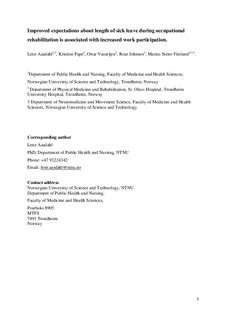Improved expectations about length of sick leave during occupational rehabilitation is associated with increased work participation
Journal article, Peer reviewed
Accepted version
Permanent lenke
http://hdl.handle.net/11250/2568428Utgivelsesdato
2018Metadata
Vis full innførselSamlinger
Originalversjon
10.1007/s10926-018-9808-4Sammendrag
Objectives
To assess changes in participants’ expectations about length of sick leave during Acceptance and Commitment Therapy (ACT)-based occupational rehabilitation, and whether the change in expectations was associated with future work participation.
Methods
Cohort study with 9 months follow-up including sick listed workers who took part in one of two randomized controlled trials. The change in expectations about length of sick leave were assessed using a test of marginal homogeneity. Furthermore, linear and logistic regression evaluated associations between changes in expectations and sustainable return to work (RTW) and work participation days.
Results
During rehabilitation, there was a statistically significant improvement in participants’ (n = 168) expectations about length of sick leave. During 9 months follow-up, participants with consistently positive expectations had the highest probability of RTW (0.81, 95% CI 0.67–0.95) and the most work participation days (159, 95% CI 139–180). Participants with improved expectations had higher probability of sustainable RTW (0.68, 95% CI 0.50–0.87) and more work participation days (133, 95% CI 110–156) compared to those with reduced (probability of RTW: 0.50, 95% CI 0.22–0.77; workdays: 116, 95% CI 85–148), or consistently negative expectations (probability of RTW: 0.23, 95% CI 0.15–0.31; workdays: 93, 95% CI 82–103).
Conclusions
During ACT-based occupational rehabilitation, 33% improved, 48% remained unaltered, and 19% of the participants reduced their expectations about RTW. Expectations about RTW can be useful to evaluate in the clinic, and as an intermediary outcome in clinical trials. The changes were associated with future work outcomes, suggesting that RTW expectations is a strong predictor for RTW.
